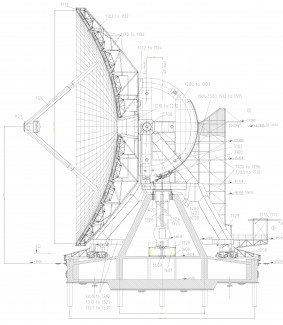
Diagram of the structural design of the 50-m Large Millimeter Telescope.
The Large Millimeter Telescope is a 50m-diameter millimeter-wave radio telescope, optimized to perform observations at millimeter wavelengths (0.85 – 4 mm). The LMT conducted a series of first-light observations at 3 mm and at 1.1 mm with the Redshift Search Receiver (RSR) and AzTEC respectively in mid 2011. Early Science campaigns, which produced the first scientific results, started in late 2013 and were conducted using the inner 32 m diameter of the primary surface. Since 2018 the LMT operates with a full 50 m active primary surface.
The full 50m-diameter primary reflector is comprised of 180 surface segments arranged in 5 concentric rings. An individual surface segment consists of 8 precision electro-formed nickel subpanels fabricated by Media Lario Technologies (and are similar in construction to panels provided by Media Lario Technologies for the European ALMA antennas). The subpanels are aligned and attached to a supporting structure to produce a single surface segment. Each segment is connected to the antenna backstructure and aligned, via actuators, to provide the LMT’s active parabolic primary reflector. The active surface corrections continuously compensate for the elevation-dependent gravitational deformations of the antenna. For the initial astronomical tests and the first Early Science observations (ES1) in the Spring of 2013, the reflector surface was set to a single elevation of 61 degrees using holographic measurements of geostationary satellites at 12 GHz. In the Autumn of 2013 the active primary surface was installed and commissioned, providing optimal constant gain on a wide elevation range (between 20 and 85 degrees). The 50m primary active surface was complete and commissioned in 2018.
The LMT is a bent Cassegrain optical system with a 2.5m-diameter secondary mirror and a flat tertiary mirror located on the telescope’s elevation axis. The secondary mirror is a machined aluminum mirror with an rms of 30 microns, and is attached to the telescope with an active hexapod which allows optimization of the focus, lateral offsets, and tilts. The tertiary mirror tracks the telescope elevation angle and delivers the beam to the receivers.
Through the use of an optical telescope mounted on the antenna, it has been possible to evaluate the pointing and tracking behavior of the telescope mount. These measurements demonstrated tracking accuracies well below one arcsec, and absolute pointing observations that are consistent with errors of 3 arcsec rms. The rms for offset pointing from nearby sources, demonstrated with the optical camera, is considerably better and approaches the specification of 1 arcsec rms.
The LMT’s Telescope Control System was developed and put to use on the FCRAO 14m telescope during its final years of operation. The LMT’s Data Collection System, which coordinates operation of the telescope and its instruments to produce scientific data, was developed based on experience with the 14m telescope. This system was used successfully since the LMT started operations: with our test instruments (Optical Camera and Holography System) and with the two initial scientific instruments (AzTEC and Redshift Search Receiver).